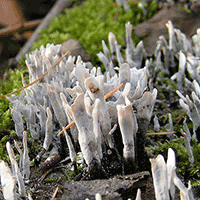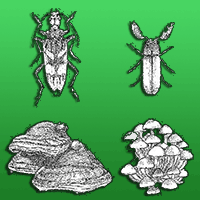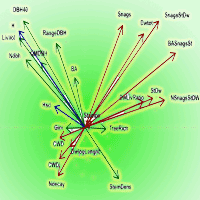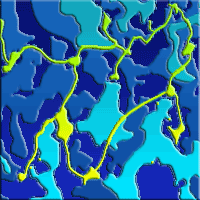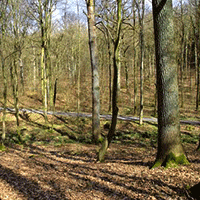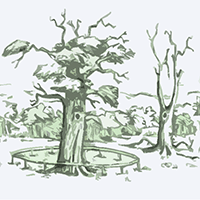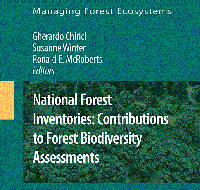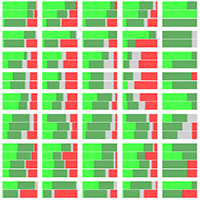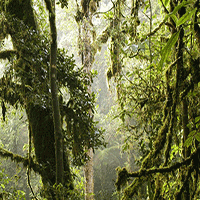Old-growth forests are key elements of ecosystem diversity and conservation strategies, providing niche differentiation and trophic pathways that produce structural and compositional heterogeneity. In these forests, deadwood is particularly important for saproxylic and mycorrhizal fungi, sustaining forest productivity and environmental services. In this study, the saproxylic fungal diversity in Mediterranean mountain forests, characterized by different management histories and forest types (holm oak and beech), was analyzed. The relationships between saproxylic fungal biodiversity and structural attributes were considered in three forest stands of the Apennines (Italy). In addition, descriptive environmental parameters and forest traits were related to prevailing fungal communities, in order to analyze the species composition and distribution patterns of saproxylic fungi resulting from the ordination processes. The study sites were selected on the basis of their late-serial stage of development. Species frequency was analyzed through multivariate techniques to test the relationships between fungi, structural attributes and environmental variables. A Detrended Correspondence Analysis (DCA) was used to investigate the response of the overall fungal community structure to environmental gradients. Living tree volume, altitude, vegetation type, and the frequency of species with ephemeral sporocarp lifespan played a crucial role in diversifying species distribution patterns. Deadwood volume and decay classes were related to taxonomic and trophic community diversity. However, differences between the considered climatic regions exerted a major role on the occurrence of fungi with ephemeral sporocarps more than deadwood abundance, utilized primarily as fructification substrate.
Keywords
, , , , ,
Citation
Persiani AM, Lombardi F, Lunghini D, Granito VM, Tognetti R, Maggi O, Pioli S, Marchetti M (2015). Stand structure and deadwood amount influences saproxylic fungal biodiversity in Mediterranean mountain unmanaged forests. iForest 9: 115-124. - doi: 10.3832/ifor1304-008
Academic Editor
Giustino Tonon
Paper history
Received: Apr 03, 2014
Accepted: Jun 29, 2015
First online: Sep 08, 2015
Publication Date: Feb 21, 2016
Publication Time: 2.37 months
© SISEF - The Italian Society of Silviculture and Forest Ecology 2015
Open Access
This article is distributed under the terms of the Creative Commons Attribution-Non Commercial 4.0 International (https://creativecommons.org/licenses/by-nc/4.0/), which permits unrestricted use, distribution, and reproduction in any medium, provided you give appropriate credit to the original author(s) and the source, provide a link to the Creative Commons license, and indicate if changes were made.

Breakdown by View Type
(Waiting for server response...)
Article Usage
Total Article Views: 54975
(from publication date up to now)
Breakdown by View Type
HTML Page Views: 44563
Abstract Page Views: 3800
PDF Downloads: 5261
Citation/Reference Downloads: 34
XML Downloads: 1317
Web Metrics
Days since publication: 3736
Overall contacts: 54975
Avg. contacts per week: 103.00
Article Citations
Article citations are based on data periodically collected from the Clarivate Web of Science web site
(last update: Mar 2025)
Total number of cites (since 2016): 33
Average cites per year: 3.30
Publication Metrics
by Dimensions ©
Articles citing this article
List of the papers citing this article based on CrossRef Cited-by.
(1)
Abrego N, Salcedo I (2011)How does fungal diversity change based on woody debris type? A case study in Northern Spain. Ekologija 57: 109-119.
CrossRef |
Gscholar
(2)
Abrego N, Salcedo I (2013)Variety of woody debris as the factor influencing wood-inhabiting fungal richness and assemblages: Is it a question of quantity or quality? Forest Ecology and Management 291: 377-385.
CrossRef |
Gscholar
(3)
Ainsworth AM (2004)Developing tools for assessing fungal interest in habitats. 1: Beech woodland saprotrophs. English Nature Research Reports 597: 1-75.
Gscholar
(4)
Allison SD, Wallenstein MD, Bradford MA (2010)Soil-carbon response to warming dependent on microbial physiology. Nature Geoscience 3: 336-340.
CrossRef |
Gscholar
(5)
Arnolds E (1981)Ecology and coenology of macrofungi in grasslands and moist heatlands in Drenthe, the Netherlands. Part1. Introduction and synecology. Bibliotheca Mycologica 83, Cramer J, Vaduz, Liechtenstein, pp. 407.
Gscholar
(6)
Arnolds E, Kuyper ThW, Noordeloos EM (1995)Overzicht van de paddestoelen in Nederland [Overview of mushrooms in the Netherlands]. Nederlandse Mycologische Vereniging, Wijster, the Netherlands, pp. 872. [in Dutch]
Gscholar
(7)
Attorre F, Francesconi F, Valenti R, Vitale M, Alfò M, Bruno F (2011)Evaluating the effects of climate change on Italian forests trough abundance measures and species composition indexes. Applied Vegetation Science 14: 242-255.
CrossRef |
Gscholar
(8)
Bader P, Jansson S, Jonsson BG (1995)Wood-inhabiting fungi and substratum decline in selectively logged boreal spruce forests. Biological Conservation 72: 355-362.
CrossRef |
Gscholar
(9)
Bassler C, Muller J, Svoboda M, Lepsova A, Hahn C, Holzer H, Pouska V (2012)Diversity of wood-decaying fungi under different disturbance regimes - a case study from spruce mountain forests. Biodiversity and Conservation 21: 33-49.
CrossRef |
Gscholar
(10)
Berglund H, Edman M, Ericson L (2005)Temporal variation of wood-fungi diversity in boreal old-growth forests: implications for monitoring. Ecological Applications 15: 970-982.
CrossRef |
Gscholar
(11)
Blasi C, Michetti L (2007)Biodiversity and climate. In: “Biodiversity in Italy” (Blasi C, Boitani L, La Posta S, Manes F, Marchetti M eds). Palombi Editore, Rome, Italy, pp. 57-66.
Gscholar
(12)
Blasi C, Rosati L, Di Pietro R, Marchetti M, Marignani M (2005)Variazioni cenologiche e stima della diversità floristica dei boschi a
Quercus cerris del flysch del Cilento in relazione al tipo di gestione selvicolturale [Coenological variation and floristic diversity assessment in relation to forest management in
Quercus cerris woods of turbiditic substrata of Cilento National Park]. Italia Forestale e Montana 60: 387-404. [in Italian]
Gscholar
(13)
Blasi C, Marchetti M, Chiavetta U, Aleffi M, Audisio P, Azzella MM, Brunialti G, Capotorti G, Del Vico E, Lattanzi E, Persiani AM, Ravera S, Tilia A, Burrascano S (2010)Multi-taxon and forest structure sampling for old-growth indicators identification and forest monitoring. Plant Biosystems 144: 160-170.
CrossRef |
Gscholar
(14)
Boddy L (2001)Fungal community, ecology and wood decomposition processes in angiosperms: from standing tree to complete decay of coarse woody debris. Ecological Bulletins 49: 43-56.
Online |
Gscholar
(15)
Boddy L, Rayner ADM (1983)Origins of decay in living deciduous trees: the role of moisture content and a re-appraisal of the expanded concept of tree decay. New Phytologist 94: 623-641.
CrossRef |
Gscholar
(16)
Bradford MA, Warren IIRJ, Baldrian P, Crowther TW, Maynard DS, Oldfield EE, Wieder WR, Wood SA, King JR (2014)Climate fails to predict wood decomposition at regional scales. Nature Climate Change.
CrossRef |
Gscholar
(17)
Bradshaw CJA, Warkentin IG, Sodhi NS (2009)Urgent preservation of boreal carbon stocks and biodiversity. Trends in Ecology and Evolution 24: 541-548.
CrossRef |
Gscholar
(18)
Burrascano S, Rosati L, Blasi C (2009)Plant species diversity in Mediterranean old-growth forests: a case study from central Italy. Plant Biosystems 143: 190-200.
CrossRef |
Gscholar
(19)
Burrascano S, Keeton WS, Sabatini FM, Blasi C (2013)Commonality and variability in the structural attributes of moist temperate old-growth forests: a global review. Forest Ecology and Management 291: 458-479.
CrossRef |
Gscholar
(20)
Cannon PF, Kirk PM (2007)Fungal families of the world. CABI Publishing, Wallingford, UK, pp. 456.
Online |
Gscholar
(21)
Chiesi M, Maselli F, Chirici G, Corona P, Lombardi F, Tognetti R, Marchetti M (2013)Assessing most relevant factors to simulate current annual increments of beech forests in Italy. iForest 7: 115-122.
CrossRef |
Gscholar
(22)
Christensen M, Heilmann-Clausen J, Walleyn R, Adamcik S (2004)Wood-inhabiting fungi as indicators of nature value in European beech forests. In: “Monitoring and Indicator of Forest Biodiversity in Europe. From Ideas to Operationality” (Marchetti M ed). EFI Proceedings 51: 229-237.
Gscholar
(23)
Christensen M, Hahn K, Mountford EP, Odor P, Standovar T, Rozenbergar D, Diaci J, Wijdeven S, Mayer P, Winter S, Vrska T (2005)Deadwood in European beech (
Fagus sylvatica) forest reserves. Forest Ecology and Management 210: 267-282.
CrossRef |
Gscholar
(24)
Ciesla WM (2002)Non-wood forest products from temperate broad-leaved trees. Non-Wood Forest Products 15, FAO Technical Papers, Rome, Italy, pp. 125.
Online |
Gscholar
(25)
Corona P, Blasi C, Chirici G, Facioni L, Fattorini L, Ferrari B (2010)Monitoring and assessing old-growth forest stands by plot sampling. Plant Biosystems 144: 171-179.
CrossRef |
Gscholar
(26)
Dämon W (2001)Die corticioiden Basidienpilze des Bundeslandes Salzburg (Österreich) [The corticioid Basidiomycetes of the province of Salzburg (Austria)]. Floristik, Lebensräume und Substratökologie. Bibliotheca Mycologica 189: 1-413. [in German]
Gscholar
(27)
Dighton J (2003)Fungi in ecosystem processes. Marcel Dekker, New York, USA, pp. 432.
Gscholar
(28)
Fischer R, Granke O, Chirici G, Meyer P, Seidling W, Stofer S, Corona P, Marchetti M, Travaglini D (2009)Background, main results and conclusions from a test phase for biodiversity assessments on intensive forest monitoring plots in Europe. iForest 2: 67-74.
CrossRef |
Gscholar
(29)
Franklin JF, Spies TA (1991)Composition, function, and structure of old-growth Douglas-fir forests. In: “Wildlife and vegetation of unmanaged Douglas-fir forests” (Ruggiero LF, Aubry KB, Carey AB, Huff MH eds). Gen. Tech. Rep. PNW-GTR-285, USDA Forest Service, Portland, OR, USA, pp. 91-110.
Online |
Gscholar
(30)
Gates G, Mohammed C, Wardlaw T, Ratkowsky DA, Davidson NJ (2011)The ecology and diversity of wood-inhabiting macrofungi in a native Eucalyptus oblique forest of southern Tasmania, Australia. Fungal Ecology 4: 56-67.
CrossRef |
Gscholar
(31)
Granito VM, Lunghini D, Maggi O, Persiani AM (2015)Wood-inhabiting fungi in southern Italy forest stand: morphogroups, vegetation types and decay class. Mycologia [in press]
Online |
Gscholar
(32)
Hahn K, Christensen M (2004)Dynamics of deadwood in European beech forests in relation to natural disturbances. Rit Mogilsar Rannsoknastodvar Skogræktar, Iceland Forest Research Bullettin 22: 5-8.
Gscholar
(33)
Hanewinkel M, Cullmann DA, Schelhaas MJ, Nabuurs GJ, Zimmermann NE (2012)Climate change may cause severe loss in the economic value of European forest land. Nature Climate Change 3: 203-207.
CrossRef |
Gscholar
(34)
Harmon ME, Franklin JF, Swanson FJ, Sollins P, Gregory SV, Lattin JD, Anderson NH, Cline SP, Aumen NG, Sedell JR, Lienkaemper GW, Cromack Jr K, Cummins KW (1986)Ecology of coarse woody debris in temperate ecosystem. Advances in Ecological Research 15: 133-302.
CrossRef |
Gscholar
(35)
Heilmann-Clausen J (2001)A gradient analysis of communities of macrofungi and slime moulds on decaying beech logs. Mycological Research 105: 575-596.
CrossRef |
Gscholar
(36)
Heilmann-Clausen J (2005)Diversity of saproxylic fungi on decaying beech wood in protected forests in the county of Halland. Meddelande 2005:7, Länsstyrelsen Halland, Sweden, pp. 64.
Gscholar
(37)
Heilmann-Clausen J, Christensen M (2003)Fungal diversity on decaying beech logs - implications for sustainable forestry. Biodiversity Conservation 12: 953-973.
CrossRef |
Gscholar
(38)
Hendry SJ, Boddy L, Lonsdale D (1993)Interactions between callus cultures of European beech, indigenous ascomycetes and derived fungal extracts. New Phytologist 123: 421-428.
CrossRef |
Gscholar
(39)
Herrero C, Krankina O, Monleon VJ, Bravo F (2013)Amount and distribution of coarse woody debris in pine ecosystems of north-western Spain, Russia and the United States. iForest 7: 53-60.
CrossRef |
Gscholar
(40)
Hill MO, Gauch HG (1980)Detrended correspondence analysis: an improved ordination technique. Vegetatio 42: 47-58.
CrossRef |
Gscholar
(41)
Holub SM, Spears JDH, Lajtha K (2001)A reanalysis of nutrient dynamics in coniferous coarse woody debris. Canadian Journal of Forest Research 31: 1894-1902.
CrossRef |
Gscholar
(42)
Humphrey JW, Davey S, Peace AJ, Ferris R, Harding K (2002)Lichens and bryophyte communities of planted and semi-natural forests in Britain: the influence of site type, stand structure and deadwood. Biological Conservation 107: 165-180.
CrossRef |
Gscholar
(43)
Hunter ML (1990)Wildlife, forests, and forestry: principles of managing forests for biological diversity. Prentice Hall, Englewood Cliffs, NJ, USA, pp. 370.
Online |
Gscholar
(44)
Jansson G, Andrén H (2003)Habitat composition and bird diversity in managed boreal forests. Scandinavian Journal of Forest Research 18: 225-236.
CrossRef |
Gscholar
(45)
Junninen K, Komonen A (2011)Conservation ecology of boreal polypores: a review. Biological Conservation 144: 11-20.
CrossRef |
Gscholar
(46)
Junninen K, Simila M, Kouki J, Kotiranta H (2006)Assemblages of wood inhabiting fungi along the gradients of succession and naturalness in boreal pine-dominated forests in Fennoscandia. Ecography 29: 75-83.
CrossRef |
Gscholar
(47)
Kirk PM, Cannon PF, Minter DW, Stalpers JA (2008)Dictionary of the Fungi (10th edn). CABI Publishing, Wallingford, UK, pp. 771.
Gscholar
(48)
Kraus D, Krumm F (2013)Integrative approaches as an opportunity for the conservation of forest biodiversity. European Forest Institute, Freiburg, Germany, pp. 284.
Gscholar
(49)
Küffer N, Senn-Irlet B (2005a)Influence of forest management on the species richness and composition of wood-inhabiting basidiomycetes in Swiss forests. Biodiversity Conservation 14: 2419-2453.
CrossRef |
Gscholar
(50)
Küffer N, Senn-Irlet B (2005b)Diversity and ecology of wood-inhabiting aphyllophoroid basidiomycetes on fallen woody debris in various forest types in Switzerland. Mycological Progress 4: 77-86.
CrossRef |
Gscholar
(51)
Küffer N, Gillet F, Senn-Irlet B, Aragno M, Job D (2008)Ecological determinants of fungal diversity on dead wood in European forests. Fungal Diversity 30: 83-95.
Online |
Gscholar
(52)
Laiho R, Prescott CE (1999)The contribution of coarse woody debris to carbon, nitrogen, and phosphorus cycles in three Rocky Mountain coniferous forests. Canadian Journal of Forest Research 29 (10): 1592-1603.
CrossRef |
Gscholar
(53)
Lassauce A, Paillet Y, Jactel H, Bouget C (2011)Deadwood as a surrogate for forest biodiversity: meta-analysis of correlations between deadwood volume and species richness of saproxylic organisms. Ecological Indicators 11: 1027-1039.
CrossRef |
Gscholar
(54)
Lasserre B, Marchetti M, Tognetti R (2006)Problems in the inventory of the belowground forest biomass carbon stocks. Forest@ 3 (4): 542-554. [in Italian with English summary]
CrossRef |
Gscholar
(55)
Lasserre B, Motta E, D’Amico L, Scirè M, Marchetti M (2010)Using the Resistograph® to distinguish different types of wood rot on living silver fir in Molise (Italy). Forest@ 7: 190-198. [in Italian with English summary]
CrossRef |
Gscholar
(56)
Lindblad I (1998)Wood-inhabiting fungi on fallen logs of Norway spruce: Relations to forest management and substrate quality. Nordic Journal of Botany 18: 243-255.
CrossRef |
Gscholar
(57)
Lodge DJ, Ammirati JF, O’Dell TE, Mueller GM, Huhndorf SM, Wang CJ (2004)Terrestrial and lignicolous macrofungi. In: “Biodiversity of fungi: Inventory and Monitoring Methods” (Mueller GM, Bills GF, Foster MS eds). Elsevier, Academic Press, London, UK, pp. 127-172.
Online |
Gscholar
(58)
Lombardi F, Chirici G, Marchetti M, Tognetti R, Lasserre B, Corona P, Barbati A, Ferrari B, Di Paolo S, Giuliarelli D, Mason F, Iovino F, Nicolaci A, Bianchi L, Maltoni A, Travaglini D (2010)Deadwood in forest stands close to old-growthness under Mediterranean conditions in the Italian Peninsula. Italian Journal of Forest and Mountain Environment 65: 481-504.
CrossRef |
Gscholar
(59)
Lombardi F, Cocozza C, Lasserre B, Tognetti R, Marchetti M (2011)Dendrochronological assessment of time-since-death in the old-growth Magellan’s beech forest of Navarino Island (Chile). Austral Ecology 36: 329-340.
CrossRef |
Gscholar
(60)
Lombardi F, Lasserre B, Chirici G, Tognetti R, Marchetti M (2012)Deadwood occurrence and forest structure as indicators of old-growth forest conditions in Mediterranean mountainous ecosystems. Ecoscience 19: 344-355.
CrossRef |
Gscholar
(61)
McCune B, Mefford MJ (2006)PC-ORD Multivariate analysis of ecological data (Version 5.10). MjM Software, Gleneden Beach, Oregon, USA.
Gscholar
(62)
Mackensen J, Bauhus J, Webber E (2003)Decomposition rates of coarse woody debris - a review with particular emphasis on Australian tree species. Australian Journal of Botany 51: 27-37.
CrossRef |
Gscholar
(63)
Marchetti M, Lombardi F (2006)Analisi quali-quantitativa del legno morto in soprassuoli non gestiti: Il caso di “Bosco Pennataro”, Alto Molise [Quali-quantitative analyses of deadwood in unmanaged stand: “Bosco Pennataro”, Alto Molise]. Italian Journal of Forest and Mountain Environment 4: 275-302. [in Italian]
CrossRef |
Gscholar
(64)
Marchetti M, Tognetti R, Lombardi F, Chiavetta U, Palumbo G, Sellitto M, Colombo C, Iovieno P, Alfani A, Baldantoni D, Barbati A, Ferrari B, Bonacquisti S, Capotorti G, Copiz R, Blasi C (2010)Ecological portrayal of old-growth forests and persistent woodlands in the Cilento and Vallo di Diano National Park (southern Italy). Plant Biosystems 144: 130-147.
CrossRef |
Gscholar
(65)
Marinšek A, Šilc U, Carni A (2013)Geographical and ecological differentiation of
Fagus forest vegetation in SE Europe. Applied Vegetation Science 16: 131-147.
CrossRef |
Gscholar
(66)
Martin F, Nehls U (2009)Harnessing ectomycorrhizal genomics for ecological insights. Current Opinion in Plant Biology 12: 508-515.
CrossRef |
Gscholar
(67)
Mazzoleni S, Loporto A, Blasi C (1992)Multivariate analysis of climate patterns of the Mediterranean basin. Vegetatio 98: 1-12.
CrossRef |
Gscholar
(68)
Müller J, Engel H, Blaschke M (2007)Assemblages of wood-inhabiting fungi related to silvicultural management intensity in beech forests in southern Germany. European Journal of Forest Research 126: 513-527.
CrossRef |
Gscholar
(69)
Nocentini S (2009)Structure and management of beech (
Fagus sylvatica L.) forests in Italy. iForest 2: 105-113.
CrossRef |
Gscholar
(70)
Nordén B, Paltto H (2001)Wood-decay fungi in hazel wood: species richness correlated to stand age and dead wood features. Biological Conservation 101: 1-8.
CrossRef |
Gscholar
(71)
Nordén B, Ryberg M, Götmark F, Olausson B (2004)Relative importance of coarse and fine woody debris for the diversity of wood-inhabiting fungi in temperate broadleaf forests. Biological Conservation 117: 1-10.
CrossRef |
Gscholar
(72)
Nordén B, Paltto H, Götmark F, Kjell W (2007)Indicators of biodiversity, what do they indicate? - Lessons for conservation of cryptogams in oak-rich forest. Biological Conservation 135: 369-379.
CrossRef |
Gscholar
(73)
Odor P, Heilmann-Clausen J, Christensen M, Aude E, van Dort KW, Piltaver A, Siller I, Veerkamp MT, Walleyn R, Standovár T, van Hees AFM, Kosec J, Matočec N, Kraigher H, Grebenc T (2001)Diversity and composition of dead wood inhabiting fungal and bryophyte communities in semi-natural beech forests in Europe. Nat-Man Working, Report 31, Nat-Man Project, Forest & Landscape, University of Copenhagen, Denmark, pp. 60.
Online |
Gscholar
(74)
Odor P, Heilmann-Clausen J, Christensen M, Aude E, van Dort KW, Piltaver A, Siller I, Veerkamp MT, Walleyn R, Standovár T, van Hees AFM, Kosec J, Matočec N, Kraigher H, Grebenc T (2006)Diversity of dead wood inhabiting fungi and bryophytes in semi-natural beech forests in Europe. Biological Conservation 131: 58-71.
CrossRef |
Gscholar
(75)
Ogura-Tsujita Y, Gebauer G, Hashimoto T, Umata H, Yukawa T (2009)Evidence for novel and specialized mycorrhizal parasitism: the orchid
Gastrodia confusa gains carbon from saprotrophic
Mycena. Proceedings of the Royal Society B 276: 761-767.
CrossRef |
Gscholar
(76)
Paoletti E, Tuovinen J-P (2011)COST Action FP0903: research, monitoring and modelling in the study of climate change and air pollution impacts on forest ecosystems. iForest 4: 160-161.
CrossRef |
Gscholar
(77)
Parfitt D, Hunt J, Dockrell D, Rogers HJ, Boddy L (2010)Do all trees carry the seeds of their own destruction? PCR reveals numerous wood decay fungi latently present in sapwood of a wide range of angiosperm trees. Fungal Ecology 3: 338-346.
CrossRef |
Gscholar
(78)
Penttilä R, Siitonen J, Kuusinen M (2004)Polypore diversity in managed and old-growth boreal
Picea abies forests in southern Finland. Biological Conservation 117: 271-283.
CrossRef |
Gscholar
(79)
Penman J, Gytarsky M, Hiraishi T, Krug T, Kruger D, Pipatti R, Buendia L, Miwa K, Ngara T, Tanabe K, Wagner F (2003)Good practice guidance for land use, land-use change and forestry. Intergovernmental Panel on Climate Change, IPCC National Greenhouse Gas Inventories Programme, Kamiyamaguchi Hayama, Kanagawa, Japan, pp. 590.
Online |
Gscholar
(80)
Persiani AM, Audisio P, Lunghini D, Maggi O, Granito VM, Biscaccianti AB, Chiavetta U, Marchetti M (2010)Linking taxonomical and functional biodiversity of saproxylic fungi and beetles in broad-leaved forests in southern Italy with varying management histories. Plant Biosystems 144: 250-261.
CrossRef |
Gscholar
(81)
Peterken GF (1996)Natural woodland. ecology and conservation on northern temperate regions. Cambridge University Press, Cambridge, UK, pp. 522.
Online |
Gscholar
(82)
Pouska V, Svoboda M, Leps ová A (2010)The diversity of wood-decaying fungi in relation to changing site conditions in an old-growth mountain spruce forest, Central Europe. European Journal of Forest Research 129: 219-231.
CrossRef |
Gscholar
(83)
Renvall P (1995)Community structure and dynamics of wood-rotting Basidiomycetes on decomposing conifer trunks in northern Finland. Karstenia 35: 1-51.
Gscholar
(84)
Rivas-Martìnez S, Diaz TE, Fernandez-Gonzalez F, Izco J, Loidi J, Lousa M (2002)Vascular plant communities of Spain and Portugal. Itinera Geobotanica 15: 1-2.
Gscholar
(85)
Rosati L, Di Pietro R, Blasi C (2005)La vegetazione forestale della regione temperata del “Flysch del Cilento” (Italia meridionale) [The woodlands of Temperate Region of “Flysch substrates in Cilento” (Southern Italy)]. Fitosociologia 42: 33-65. [in Italian]
Gscholar
(86)
Saitta A, Bernicchia A, Gorjón SP, Altobelli E, Granito VM, Losi C, Lunghini D, Maggi O, Medardi G, Padovan F, Pecoraro L, Vizzini A, Persiani AM (2011)Biodiversity of wood-decay fungi in Italy. Plant Biosystems 145: 958-968.
CrossRef |
Gscholar
(87)
Schwarze FWMR (2007)Wood decay under the microscope. Fungal Biology Review 21: 133-170.
CrossRef |
Gscholar
(88)
Siitonen J (2001)Forest management, coarse woody debris and saproxylic organisms: Fennoscandian boreal forests as an example. Ecological Bulletins 49: 11-41.
Online |
Gscholar
(89)
Simard SW, Perry DA, Jones MD, Myrold DD, Durall DM, Molina R (1997)Net transfer of carbon between ectomycorrhizal tree species in the field. Nature 388: 579-582.
CrossRef |
Gscholar
(90)
Singh M, Khatoon S, Singh S, Kumar V, Rawat AK, Mehrotra S (2010)Antimicrobial screening of ethnobotanically important stem bark of medicinal plants. Pharmacognosy Research 2: 254-257.
CrossRef |
Gscholar
(91)
Sippola AL, Renvall P (1999)Wood-decomposing fungi and seed-tree cutting: a 40-year perspective. Forest Ecology and Management 115: 183-201.
CrossRef |
Gscholar
(92)
Sippola AL, Similä M, Mönkkönen M, Jokimäki J (2004)Diversity of polyporous fungi (Polyporaceae) in northern boreal forests: effects of forest type and logging intensity. Scandinavian Journal of Forest Research 19: 152-163.
CrossRef |
Gscholar
(93)
Spies TA (2004)Ecological concepts and diversity of old-growth forests. Journal of Forestry 102: 14-20.
Online |
Gscholar
(94)
Stokland JN, Siitonen J, Jonsson BG (2012)Biodiversity in dead wood. Cambridge University Press, Cambridge, UK, pp. 524.
Gscholar
(95)
Tabacchi G, Di Cosmo L, Gasparini P (2011)Aboveground tree volume and phytomass prediction equations for forest species in Italy. European Journal of Forest Research 130 (6): 911-934.
CrossRef |
Gscholar
(96)
Tognetti R, Marchetti M (2006)Influenza dei cambiamenti d’uso del suolo e delle strategie di gestione del bosco sull’allocazione del carbonio nel suolo negli ecosistemi forestali [Influence of land use changes and silvicultural management strategies on soil carbon allocation in forest ecosystems]. Italia Forestale e Montana 61: 5-51. [in Italian]
Gscholar
(97)
Vitale M, Mancini M, Matteucci G, Francesconi F, Valenti R, Attorre F (2012)Model-based assessment of ecological adaptations of three forest tree species growing in Italy and impact on carbon and water balance at national scale under current and future climate scenarios. iForest 5: 235-246.
CrossRef |
Gscholar
(98)
Whalley AJS (1996)The xylariaceous way of life. Mycological Research 100: 897-922.
CrossRef |
Gscholar
(99)
Wirth C, Messier C, Bergeron Y, Frank D, Fankhänel A (2009)Old-growth forests definitions: a pragmatic view. In: “Old-growth forests: Function, fate and value” (Wirth C, Gleixner G, Heimann M eds.). Ecological Studies 207, Springer-Verlag, Berlin, Germany, pp. 11-33.
Gscholar
(100)
Woodall CW, Westfall JA (2009)Relationships between the stocking levels of live trees and dead tree attributes in forests of the United States. Forest Ecology and Management 258: 2602-2608.
CrossRef |
Gscholar
(101)
Wubet T, Christ S, Schöning I, Boch S, Gawlich M, Schnabel B, Fisher M, Buscot F (2012)Differences in soil fungal communities between European Beech (
Fagus sylvatica L.) dominated forests are related to soil and understory vegetation. PLoS ONE 7 (e47500) 1-14.
CrossRef |
Gscholar
(102)
Xu JT, Fan L (2001)Cytodifferentiation of the seeds (protocorms) and vegetative propagation corms-colonized by mycorrhizal fungi. Acta Botanica Sinica 43: 1003-1010.
Online |
Gscholar
